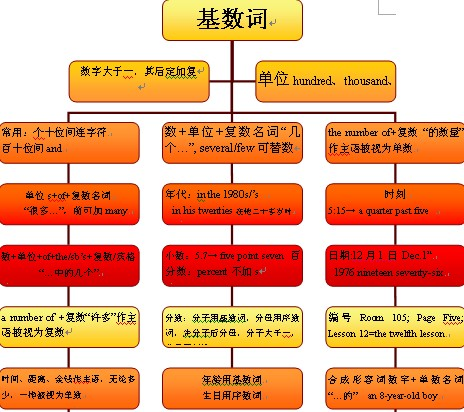本试题 “The teacher told us to write__________.A. every other linesB. every second linesC. every two linesD. every the second line” 主要考查您对基数词
形容词
等考点的理解。关于这些考点您可以点击下面的选项卡查看详细档案。
- 基数词
- 形容词
基数词的概念:
数词是指表示数目多少或顺序先后的词。表示数目多少的数词叫基数词,如one, five, ten, thirty, sixty-five等,数词与不定代词用法相似,在现代英语中,它与不定代词、冠词、指示代词、形容词性物主代词等被称之为限定词。数词用法相当于名词和形容词,在句中可用作主语、宾语、表语、定语、同位语等。
时刻的表示法:
①若为整点钟,则直接读相应的基数词;若为非整点钟,则分别以“时”和“分”为单位用相应的基数词读出:
如:twelve (12),
eight twenty (8:20),
nine forty-five (9:45)
②对于带“分”的时间,也可借助past(过)和to(差)这两个介词来表示(在美国英语中用after表示“过”)。
注:这样表示时“分”不能超过30,否则应作处理,如9.38应处理成“10点差22分”:
如:9.18 eighteen minutes past(after)nine(=nine eighteen)
10.46 fourteen minutes to eleven(=ten forty-six)
以上分钟后带了minutes一词。若“分”为5,10,15,20等五的倍数,则可省略minutes:
如:8.05 five(minutes)past[after]eight(=eight five)
9.20 twenty(minutes)past[after]nine(=nine twenty) 若“分”为15或45,可借用quarter一词;若“分”为30,可借用half一词:
如:6.15 a quarter past six
8.45 a quarter to nine
10.30 half past ten
注:时刻表示法分为12小时编时制和24小时编时制。
日期的表示法:
日期的写法(书面语)和读法(口语)稍有不同,如“十月一日”可以写成October1, October 1st, 1October, 1st October, (the)1st of October 等,表示月份的词也可用缩略式,如Oct.1, 1Oct.1,但是在口语中通常只有两种读法October(the)first或the first of October。
注:日期与星期排列时,通常是星期在前,日期在后:
如:He arrived on Friday, May10. 他于5月10日(星期五)到达。
年份的表示法:
通常以“百”为单位来读。如1986年通常读作nineteen(hundredand)eighty-six,除非在正式场合,其中的hundred and通常都省,但在通常情况下不能按普通基数词的读法那样读成one thousand nine hundred and eighty-six。不过,像1500这样的年份可以有两种读法one thousand five hundred和fifteen hundred,而2000年通常读作two thousand,2003年读作two thousand and three。若表示某个某个年代,则按类似以下的读法:1980s读作nineteen-eighties(20世纪80年代),1600s读作sixteen hundreds(17世纪头10年,即1600—1610),比较:1300 thirteen hundred(1300年)。
基数词的表示法:
(1)以下是最基本的基数词:
one(1), two(2), three(3), four(4), five(5), six(6), seven(7), eight(8), nine(9), ten(10),
eleven(11), twelve(12), thirteen(13), fourteen(14), fifteen(15), sixteen(16), seventeen(17), eighteen(18), nineteen(19),
twenty(20), thirty(30), forty(40), fifty(50), sixty(60), seventy(70), eighty(80), ninety(90), a hundred(100), a thousand(1000), a million(1000000), a billion(十亿)
(2)21—99的表示法。先说“几十”,再说“几”,中间加连字号:
如:twenty-one(21),
thirty-six(36),
forty-five(45),
ninety-nine(99)等。
(3)101—999的表示法。先说“几百”,后接and,再加末尾两位数(或末位数):
如:one hundred and one(101),
five hundred and thirty(530),
seventy hundred and eighty-nine(789)
(4)1000以上的基数词的表示法。先从右至左数,每三位数加一个逗号(即以此把数目分为若干段)。
第一个逗号前的数为thousand(千),第二个逗号前的数million(百万),第三个逗号前的数为billion(十亿),第四个逗号前的数为trillion(万亿),然后一段一段地数:
如:9,883 nine thousand, eigh thundred and eighty-three
65,359 sixty-five thousand, three hundred and fifty-nine
265,468 two hundred and sixty-five thousand, four hundred and sixty-eight
60,263,150 sixty million, two hundred and sixty-three thousand,one hundred and fifty
注:①英语没有“万”这个单位,要表示“万”须借用thousand,如“一万”用“十千”表示(ten thousand),“十万”用“百千”表示(one hundred thousand)。
②hundred, thousand, million, billion等词在读数时不带复数词尾-s(即用单数形式)。
③在hundred后通常加上连词,不过此and在美国英语中可以省略。若读数中没有hundred,则在thousand后加and。
④一个数的最高位若为“一”,这个“一”可用a或one表示,但在数字中间的“一”,则只能用one,不能用a:
如:1600a[one]thousand and six hundred
6100 six thousand and one hundred (其中的one不可改为a)
⑤在非正式场合,人们也常以hundred为单位来读数
如:It cost fifteen hundred pounds. 这东西花了1500英镑。
基数词知识体系:

用于复数形式的基数词:
(1)表示整十的基数词用复数形式可以表示人的岁数或年代:
如:in the sixties 在60年代
in one's thirties 在某人30多岁时
(2)基数词转化为名词,可用复数形式:
如:How many twos are there in ten? 10里面有几个2?
Thesoldiersmarchedintens.士兵们10人一排前进。
(3)某些习语中也用复数形式的基数词:
如:in[by] twos and threes 三三两两地
at sixes and sevens 乱其八糟
表示倍数的基数词:
1、倍数+as +形容词/副词(原级)+ as+比较对象。
如: 这座桥是那座桥的三倍长。
This bridge is three times as long as that one.
2. 倍数+形容词或副词的比较级+than+比较对象。
如:这座桥是那座桥的三倍长。
This bridge is three times longer than that one.
3. 倍数+ the size/length/weight…+of+表示比较对象的名词。
如:这座桥是那座桥的三倍长。
This bridge is three times the length of that one.
形容词的概念:
形容词(adjective),简称adj.或a,形容词用来修饰名词或代词,表示人或事物的性质、状态,和特征的程度好坏与否,形容词在句中作定语、表语、宾语补足语。通常,可将形容词分成性质形容词和叙述形容词两类,其位置不一定都放在名词前面。
形容词的作用与位置:
形容词是用来修饰名词的,常被放在名词前作定语,或放在系动词后面作表语。以下属几种特殊情况,须牢记;
(1)形容词短语作定语,定语后置。
如:a language difficult to master,
a leaning tower about 180 feet high
(2)表语形容词(afraid、alike、alone、asleep、awake、alive等)作定语,定语后置。如a man alive。有些表身体健康状况的形容词如well、faint、ill只作表语。sick既可作表语又可作定语,ill如作定语意为“bad”。
(3)用作定语,修饰由不定代词one、no、any、some和every构成的复合词如anything、something等时,通常后置。
如:I have something important to tell you.
(4)else常用作疑问代词和不定代词的后置定语。
(5)enough、nearby修饰名词前置或后置,程度副词一般位于形容词、副词前面,enough修饰形容词、副词时,必须后置。
(6)几个并列的形容词作定语,其语序通常为:限定语(The、A)+描绘性形容词+size(大小)+shape(形状)+age(年龄、时间)+color(颜色)+origin(国籍、来源)+material(材料)+purpose(目的)+名词。
口诀:
限定描绘大长高,形状年龄和新老;颜色国籍跟材料,作用类别往后靠。
如:a heavy black Chinese steel umbrella,
the man's first tow interesting little red French oil paintings
形容词的用法:
1、形容词修饰名词,说明事物或人的性质或特征。通常,可将形容词分成性质形容词和叙述形容词两类,其位置不一定都放在名词前面:
1)直接说明事物的性质或特征的形容词是性质形容词,它有级的变化,可以用程度副词修饰,在句中可作定语、表语和补语。例如:hot热的。
2)叙述形容词只能作表语,所以又称为表语形容词。这类形容词没有级的变化,也不可用程度副词修饰。
大多数以a开头的形容词都属于这一类。例如:
afraid害怕的。(错)Heisanillman. (对)Themanisill. (错)Sheisanafraidgirl. (对)Thegirlisafraid.
这类词还有:well,unwell,ill,faint,afraid,alike,alive,alone,asleep,awake等。
3)形容词作定语修饰名词时,要放在名词的前边。但是如果形容词修饰以-thing为字尾的词语时,要放在这些词之后。例如:somethingnice
2、用形容词表示类别和整体:
1)某些形容词加上定冠词可以泛指一类人,与谓语动词的复数连接。如:the dead,the living,the rich,the poor,the blind,the hungry The poorarelosinghope.穷人失去了希望。
2)有关国家和民族的形容词加上定冠词指这个民族的整体,与动词的复数连用。如:the British,the English,the French,the Chinese. The English have wonderful senseofhumor.
以-ly结尾的形容词:
1)大部分形容词加-ly可构成副词。但friendly,deadly,lovely,lonely,likely,lively,ugly,brotherly,仍为形容词。改错:
如:(错)She sang lovely.
(错)He spoke to me very friendly.
(对)Her singing was lovely.
(对)He spoke to me in a very friendly way.
2)有些以-ly结尾既为形容词,也为副词。 daily,weekly,monthly,yearly,early .
如:The Times is a daily paper.
The Times is published daily.
形容词知识体系:

复合形容词的构成:
(1)形容词+名词+ed:
如:kind-hearted 好心的,white-haired 白发的
(2)形容词+形容词:
如:red-hot 炽热的,dark-blue 深蓝的
(3)形容词+现在分词:
如:good-looking 好看的,easy-going 随和的
(4)副词+现在分词:
如:hard-working 勤劳的,fast-moving 快速转动的
(5)副词+过去分词:
如:hard-won 得来不易的,newly-made 新建的
(6)名词+形容词:
如:life-long 终生的,world-famous 世界闻名的
(7)名词+现在分词:
如:peace-loving 爱好和平的,fun-loving 爱开玩笑的
(8)名词+过去分词:
如:snow-covered 白雪覆盖的,hand-made 手工的
(9)数词+名词+ed:
如:four-storeyed 4层楼的,three-legged 3条腿的
(10)数词+名词(名词用单数):
如:ten-year 10年的, two-man 两人的
与“The teacher told us to write__________.A. every other lin...”考查相似的试题有:
- So many thousands of ___________people died.A.terrifiedB.terrifyingC.to terrifyD.were terrified
- __________ of furniture have been tested to guarantee good quality.A.A great deal ofB.A large number ofC.Large qua...
- John complained to the bookseller that there were several pages______in the dictionary. A.missingB.losingC.droppin...
- From his _______look, I could see that he didn’t believe what I said.A.amazingB.amazeC.amazedD.amazement
- The manager said that they had an _____ plan if the plan they had submitted was not accepted.A.alternateB.alternati...
- In the first week, Jenna went to tryouts(选拔赛)for cheerleaders(拉拉队队员). She was competingagainst very talen...
- Speaking of all the songs he has written, I think this is probably his____one.better-known B. well-known C. best-know...
- 12. Although he was not _____ tired, he didn’t care _____.A.a little; a littleB.a bit; a bitC.a little; a bitD.a ...
- 单词拼写。1.The students are discussing the t_________ of a novel.2. There are v_________ wild flowers in the valley....
- ---Have you read the book?---Yes. But that one is _____worth reading. I suggest you______ it if you have time.A.best...